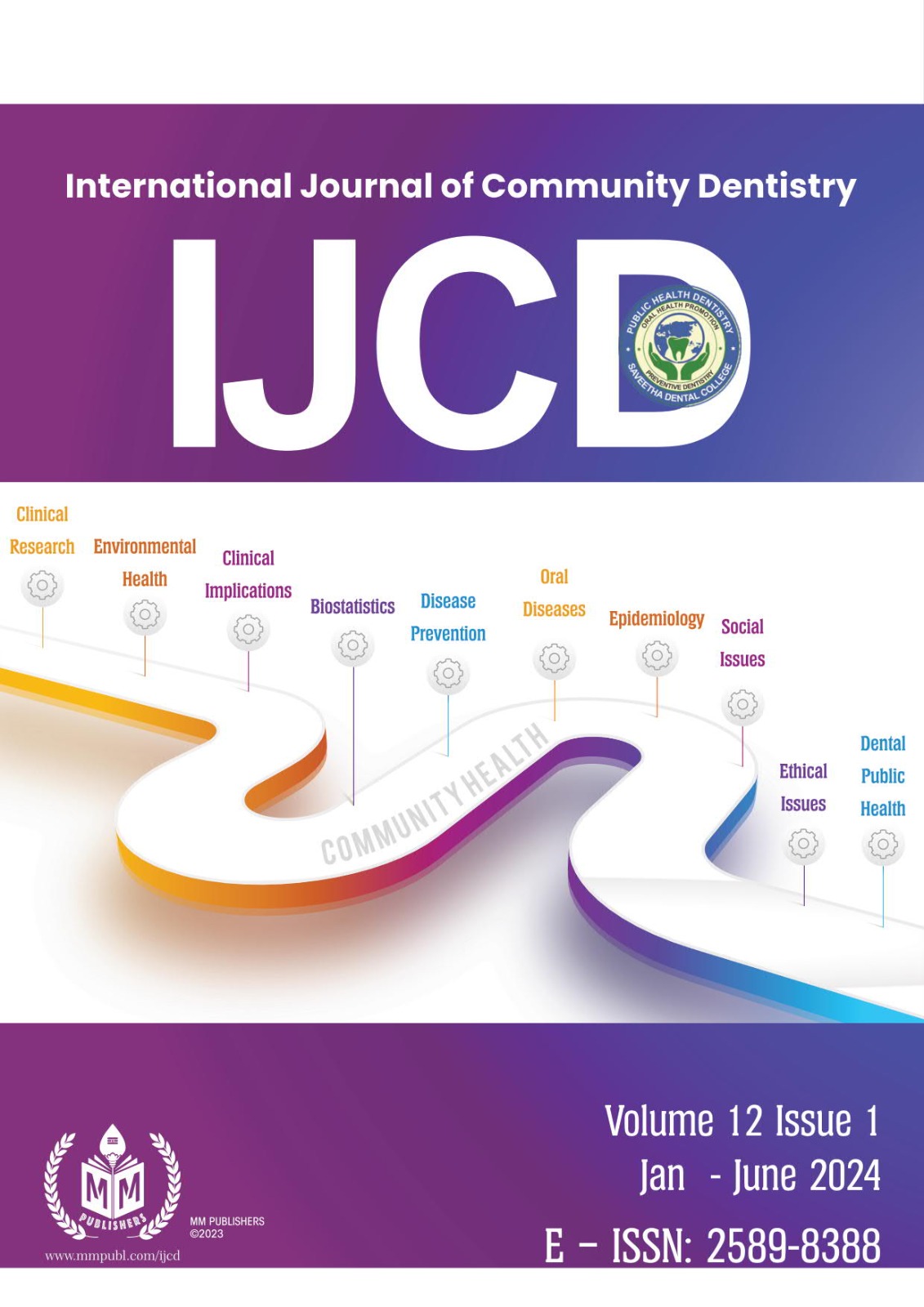Intraoral scanners in Orthodontics
Review Article
DOI:
https://doi.org/10.56501/intjcommunitydent.v12i1.1109Keywords:
Intraoral scanners, light source , impression , advancementsAbstract
Rapid advancements in digital technology have changed a number of sectors in recent years. Artificial intelligence (AI) and robotics are two examples of advanced technology that have been adopted into the medical industry. The intraoral scanner is a portable device with a tiny optical camera that collects virtual dental models that is widely employed in dentistry that works by projecting structured light (white, red, or blue). The program then compiles the individual photos or video that are captured after identifying certain locations of interest. The points of interest captured from various perspectives are then matched to create a 3D model. One of the biggest benefits of intraoral scanning is that it eliminates all the painful parts of taking a traditional impression and allows for the simple rescanning of certain areas that may not have been recorded completely. Hence, this review article will be discussed on principles of imaging, different brands of IOS, advantages and advancements in IOS.
References
Kravitz ND, Groth C, Jones PE, Graham JW, Redmond WR. Intraoral digital scanners. J Clin Orthod. 2014 Jun;48(6):337-47.
Hwang, Henry Hann-Min; Chou, Chi-Wei; Chen, Yi-Jane; and Yao, Chung-Chen Jane (2018) "An Overview of Digital Intraoral Scanners: Past, Present and Future- From an Orthodontic Perspective," Taiwanese Journal of Orthodontics: Vol. 30: Iss. 3, Article 3.
Catherine B. Martin, Elsinore V. Chalmers, Grant T. McIntyre, Heather Cochrane , Orthodontic scanners: what’s available?, Journal of Orthodontics, Vol. 42, 2015, 136–143.
Carvalho, P.E.G., Ortega, A., Maeda, F.A. et al. Digital Scanning in Modern Orthodontics. Curr Oral Health Rep 6, 269–276 (2019).
Yun D, Choi DS, Jang I, Cha BK. Clinical application of an intraoral scanner for serial evaluation of orthodontic tooth movement: A preliminary study. Korean J Orthod. 2018 Jul;48(4):262-267.
Christopoulou I, Kaklamanos EG, Makrygiannakis MA, Bitsanis I, Perlea P, Tsolakis AI. Intraoral Scanners in Orthodontics: A Critical Review. Int J Environ Res Public Health. 2022 Jan 27;19(3):1407.
Pahuja N, Doneria D, Mathur S. Comparative Evaluation of Accuracy of Intraoral Scanners vs Conventional Method in Establishing Dental Measurements in Mixed Dentition. World J Dent 2023;14(5):419–424.
Pellitteri F, Albertini P, Vogrig A. et al. Comparative analysis of intraoral scanners accuracy using 3D software: an in vivo study. Prog Orthod. 23, 21 (2022).
Thomas AA, Jain RK. Influence of Operator Experience on Scanning Time and Accuracy with Two Different Intraoral Scanners - A Prospective Clinical Trial. Turk J Orthod. 2023; 36(1): 10-14.
Lee SJ, Gallucci GO: Digital vs conventional implant impressions: efficiency outcomes. Clin Oral Implants Res 2013;24:111-115.
Stimmelmayr M, G¨ uth JF, Erdelt K, et al: Digital evaluation of the reproducibility of implant scanbody fit-an in vitro study. Clin Oral Investig 2012;16:851-856.
Kühne C, Lohbauer U, Raith S, Reich S. Measurement of Tooth Wear by Means of Digital Impressions: An In-Vitro Evaluation of Three Intraoral Scanning Systems. Applied Sciences. 2021; 11(11):5161.
Schlenz, M.A.; Schupp, B.; Schmidt, A.; Wöstmann, B.; Baresel, I.; Krämer, N.; Schulz-Weidner, N. New Caries Diagnostic Tools in Intraoral Scanners: A Comparative In Vitro Study to Established Methods in Permanent and Primary Teeth. Sensors 2022, 22, 2156.
Jung K, Giese-Kraft K, Fischer M, Schulze K, Schlueter N, Ganss C (2022) Visualization of dental plaque with a 3D-intraoral-scanner—A tool for whole mouth planimetry. PLoS ONE 17(10): e0276686.
Eom JB, Ahn JS, Eom J, Park A. Wide field of view optical coherence tomography for structural and functional diagnoses in dentistry. J Biomed Opt. 2018 Jul;23(7):1-8.

Downloads
Published
How to Cite
Issue
Section
License
Copyright (c) 2024 Senkutvan. R. S, Lokeswari parthasarathy, Mahalakshmi. K, Balaji krishnan, Karthikeyan. M, Jayaraj. R

This work is licensed under a Creative Commons Attribution-NonCommercial 4.0 International License.



